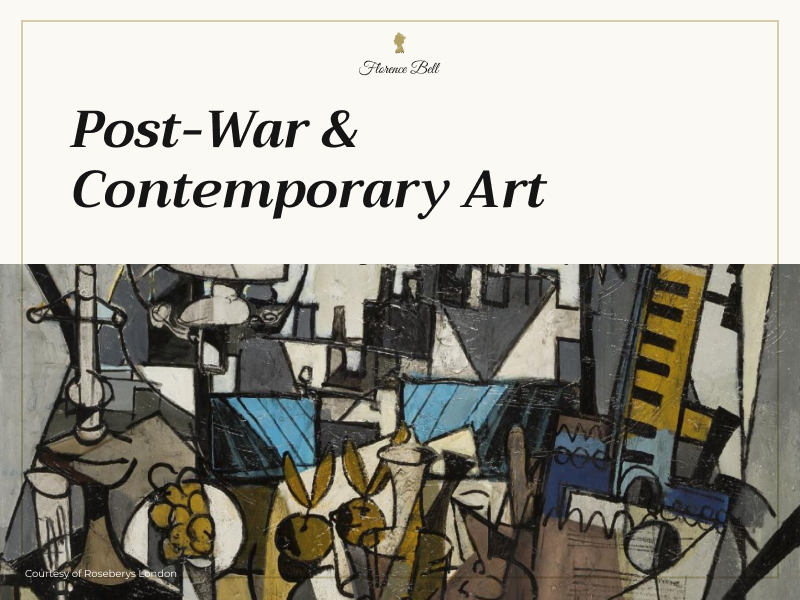 Although post-war and contemporary art is often used interchangeably or appear together in auction houses and galleries, there are important distinctions between the two. This article will shed some light on their differences.
Although post-war and contemporary art is often used interchangeably or appear together in auction houses and galleries, there are important distinctions between the two. This article will shed some light on their differences.
In your quest to become an art enthusiast or build an enviable collection, it is important to understand the nuances that separate post-war from contemporary art. While you might be forgiven for using the terms interchangeably during casual conversations about art-after all, they do have some similarities, as they both emerged after World War II- there are crucial distinctions that any art lover or serious art collector should be aware of.
So, what exactly is the difference between post-war and contemporary art?
What is Post-War Art?
Post-war art is not merely about a specific movement, but refers to a period that begins at the end of World War II (1945) and extends until the early 1970s. This timeline includes several important artistic movements, such as Abstract Expressionism, Pop Art, and Minimalism, and encompasses the cultural, social, and political changes that took place during this tumultuous time.
The artists associated with post-war art were reacting to the devastation of the war and exploring ideas about humanity, society, and modernity. While their work varies greatly in form and subject, they were influenced mainly by the effects of the war.
Post-war artists used art as a means of self-expression, a coping mechanism, and a vehicle for social and political commentary. Many artists associated with this period were influenced by Abstract Expressionism, which prioritised the inner emotions and psyche of the artist.
Pop art was another important movement that emerged during the post-war period. This movement coincided with the rise of consumer culture and the popularity of mass media. Pop artists sought to subvert traditional notions of fine art by using everyday objects and images from popular culture in their work.
Minimalism was another important artistic movement that emerged during the post-war period. Minimalist artists rejected the emotional expressiveness of Abstract Expressionism in favour of more simplified, geometric forms. They believed less was more, and that art should be about the form and materials rather than the subject.
Some of the most renowned post-war artists include Jackson Pollock, Andy Warhol, Lucian Freud, Mark Rothko, and Barnett Newman.
What is Contemporary Art?
Contemporary art refers to artworks that have been produced since the 1970s. It is characterised by its diversity, encompassing a wide range of styles, methods, and subjects.
Contemporary artists are responding to and engaging with the world around them, so their work is often topical and reflective of current events. They often use new and innovative methods and materials, and their work is often experimental.
It is challenging to pin down a specific movement or style that characterises contemporary art, as it constantly evolves. However, many argue it aims to challenge traditional art concepts and redefine what art can be.
Some of the most renowned contemporary artists include Jean-Michel Basquiat, Jeff Koons, Cindy Sherman, and Banksy.
Key Differences Between Post-War and Contemporary Art
While post-war and contemporary art emerged after World War II, there are key differences that distinguish the two.
Regarding post-war and contemporary art, the key difference lies in the timeframe. Post-war art refers to art produced between 1945 and the early 1970s, while contemporary art refers to art produced since the 1970s.
Post-war artists were reacting to the devastation of the war and exploring ideas about humanity, society, and modernity. In contrast, contemporary artists are responding to and engaging with the world around them, which means that their work is often topical and reflective of current events.
When it comes to style, post-war art is characterised by Abstract Expressionism, Post-impressionism, Realism, and more. In contrast, contemporary art is diverse, encompassing various styles, methods, and subjects.
While contemporary art is often seen as the successor to post-war art, it is important to remember that the two are distinct. Contemporary art is not simply a continuation of post-war art; it is its own distinct period with its own unique characteristics.
About Florence Bell Art Gallery
So, there you have it- a brief overview of the key differences between post-war and contemporary art. While they have some similarities, it is important to remember that they are two distinct periods with unique styles and characteristics.
If you’re interested in building your art collection with pieces from either of these periods, check out our Art Gallery. We have an extensive collection of post-war and contemporary art, so we’re sure you’ll find something you love. Get in touch with us for more information.
